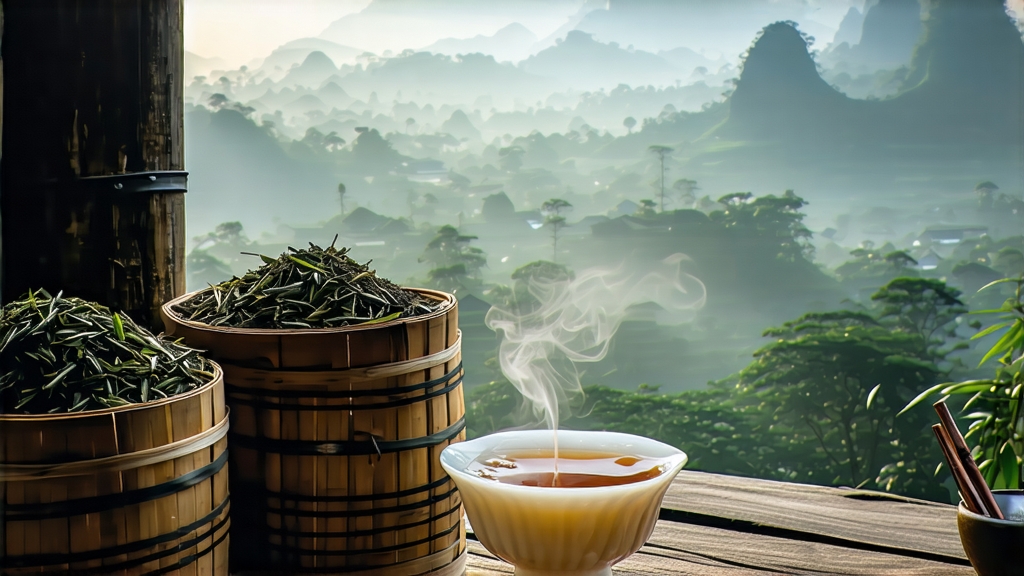
Liu Bao, literally “Six Forts,” is the quietest superstar of China’s dark-tea galaxy. While Pu-erh grabs headlines, this cousin from the subtropical mountains of southern Guangxi has spent four centuries perfecting the art of subtle power. Carried by coolies along the Ancient Tea-Horse Road, packed into bamboo baskets and lashed to the sides of mules, Liu Bao once fueled the traders who bartered horses for tea in the high Himalaya. Today it travels by container ship rather than caravan, yet every leaf still carries the scent of forest humidity and the memory of long journeys.
History begins in the Ming-era county of Cangwu, where the local Yao and Han peoples discovered that a few days of extra moisture transformed their green tea into something darker, smoother, and astonishingly digestible. By the Qing dynasty the tea had become tax currency; imperial officers accepted compressed Liu Bao bricks in lieu of silver. When the British opened Hong Kong as a free port, Cantonese merchants shipped it to Southeast Asia where tin-mine coolies swore the tea cured rheumatism and chased away malaria. In Kuala Lumpur kopitiams the name “Liu Bao” is still spoken with the same reverence Italians reserve for Barolo.
Botanically the leaf is Camellia sinensis var. sinensis, the small-leaf China plant, but the cultivars of Guangxi develop unusually thick cell walls to survive the region’s blistering summers and acidic red soils. Farmers prize three clones—Xiao Ye Zhong, Ling Yun Bai Hao, and the rare Wu Ye Cha—each lending different ratios of polyphenols and amino acids that later translate into cocoa, orchid, or camphor notes after fermentation.
Plucking follows the southern Chinese calendar: one bud and two leaves after Qingming, when spring mist still clings to the drum-shaped hills. The leaves are carried downhill in perforated bamboo tubes so they begin to wilt during the two-hour trek, an unintentional first step of enzymatic softening. Once in the village courtyard they are spread on hemp mats and left to wither under a high subtropical sun for no more than forty minutes—just long enough for the edges to curl like antique parchment.
Next comes the wok, heated with local hardwood to 280 °C. The tea master tosses three kilograms at a time, his bare forearms scarred by decades of steam. The kill-green phase lasts exactly six minutes; under-toast and the leaf will sour during piling, over-toast and the liquor becomes flat. While still hot the leaves are rolled on a bamboo tray until the cell rupture rate reaches 65 %, the sweet spot for later microbial feeding.
What distinguishes Liu Bao from other dark teas is its “wet piling” or wo dui, a gentler cousin of Pu-erh’s shou process. Instead of spraying water the workers cover the piles with wet hemp cloths; ambient humidity in Guangxi often exceeds 85 %, so nature does most of the work. The pile is left for twenty-five days, turned every five, temperature never allowed above 55 °C. A golden mold, Aspergillus chevalieri, blooms first, followed by golden-yellow yeasts that smell of ripe mango. The final turn releases a perfume that locals compare to dried longan and betel nut, the signature Liu Bao aroma known as “song xiang.”
After piling the tea is steamed, then packed by hand into cylindrical bamboo baskets lined with wild banana leaf. A skilled woman can tamp eight kilograms into a forty-centimeter tube using only a wooden pestle and her body weight; the tighter the pack, the slower the post-fermentation. These baskets are stacked in riverside warehouses where the natural temperature cycle—hot days, cool nights—drives micro-oxidation for years. The best lots age for at least a decade, during which the color shifts from rust to obsidian and the taste moves through stages of plum, camphor, and finally a deep, resinous sweetness reminiscent of oud incense.
To brew Liu Bao abroad you need not replicate a humid Guangxi cellar; a simple gaiwan and attentive heart suffice. Rinse 5 g of leaf with water just off the boil, discard immediately, then steep the first infusion for fifteen seconds. The liquor emerges the color of sherry, bright and viscous. Raise the cup to the light: clarity signals good storage, cloudiness warns of damp contamination. Sip with teeth together, letting the tea spray across the